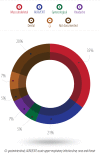Non-steroidal Anti-inflammatory Drugs (NSAIDs) Use in Primary Health Care Centers in A'Seeb, Muscat: A Clinical Audit
- PMID: 26421118
- PMCID: PMC4576381
- DOI: 10.5001/omj.2015.73
Non-steroidal Anti-inflammatory Drugs (NSAIDs) Use in Primary Health Care Centers in A'Seeb, Muscat: A Clinical Audit
Abstract
Objective: We sought to assess the trend of non-steroidal anti-inflammatory drug (NSAID) use in primary health care institutions located in A'Seeb, a province in the capital city of Oman, Muscat. Additionally, we evaluated the relationship between a physician's years of experience and the number of prescription issued, as well as the presence of risk factors and side effects in the patients who received these prescriptions.
Method: A clinical audit was conducted in four primary health care centers in the Muscat region over a one-week period in April 2014. The target population included patients aged 18 years or over who attended one of the four health centers and were prescribed NSAIDs. Overall, 272 patients were recruited by systematic random sampling. The data were collected by two methods: direct face-to-face interviews and evaluations of the patient's electronic medical file. The prescribing doctors were blind to the audit. The collected information included patients demographics, past and current medical history of related comorbidities, NSAID type, dose, duration and indications for use, concomitant warfarin or/and aspirin prescriptions, and co-prescription of gastroprotective agents.
Results: In total, 15% of patients received an NSAID prescription: females were issued more prescriptions than males. The percentage of patients who received an NSAID prescription across the health centers ranged from 9% to 24%. The main reason for prescribing NSAIDs was musculoskeletal problems. The most frequently prescribed NSAID was ibuprofen. Sixteen percent of patients who received an NSAID prescription had a risk factor related to its use. The mean and median duration of the NSAID prescriptions of all types were 5.6 and 5.0 days, respectively. Physicians with a greater number of years experience prescribed more NSAIDs.
Conclusion: Our study showed that the number of prescriptions of NSAIDs among various institutes varied, which could reflect the level of awareness concerning NSAID risks among the prescribing doctors. NSAIDs were prescribed for patients with comorbidities and patients with previously documented side effects without considering protective agents. Therefore, we suggest that the use of these medications is controlled, especially in high-risk populations.
Keywords: Anti-Inflammatory Agents, Non-Steroidal; NSAIDs; Prescriptions; side effects; utilization.
Figures
Similar articles
-
High-risk nonsteroidal anti-inflammatory drugs prescribing in primary care: results from National Medical Care Survey Malaysia.Int J Clin Pharm. 2020 Apr;42(2):489-499. doi: 10.1007/s11096-020-00966-w. Epub 2020 Jan 20. Int J Clin Pharm. 2020. PMID: 31960271
-
Prescription of nonsteroidal anti-inflammatory drugs for elderly people in Alberta.CMAJ. 1994 Aug 1;151(3):315-22. CMAJ. 1994. PMID: 8039085 Free PMC article.
-
Non-steroidal anti-inflammatory and cytoprotective drug co-prescription in general practice. A general practitioner-based survey in France.Eur J Clin Pharmacol. 2001 Dec;57(10):737-43. doi: 10.1007/s00228-001-0378-5. Eur J Clin Pharmacol. 2001. PMID: 11829204
-
Non-steroidal anti-inflammatory drug gastropathy: causes and treatment.Scand J Gastroenterol Suppl. 1996;220:124-7. doi: 10.3109/00365529609094763. Scand J Gastroenterol Suppl. 1996. PMID: 8898449 Review.
-
Epidemiology of nonsteroidal anti-inflammatory drug-associated gastrointestinal injury.Am J Med. 1998 Mar 30;104(3A):23S-29S; discussion 41S-42S. doi: 10.1016/s0002-9343(97)00207-6. Am J Med. 1998. PMID: 9572317 Review.
Cited by
-
Comparison of the Effect of Stretching Exercises and Mefenamic Acid on the Reduction of Pain and Menstruation Characteristics in Primary Dysmenorrhea: A Randomized Clinical Trial.Oman Med J. 2017 Jan;32(1):47-53. doi: 10.5001/omj.2017.09. Oman Med J. 2017. PMID: 28042403 Free PMC article.
-
Frequency and Associations of Prescription Nonsteroidal Anti-inflammatory Drug Use Among Patients With a Musculoskeletal Disorder and Hypertension, Heart Failure, or Chronic Kidney Disease.JAMA Intern Med. 2018 Nov 1;178(11):1516-1525. doi: 10.1001/jamainternmed.2018.4273. JAMA Intern Med. 2018. PMID: 30304456 Free PMC article.
-
Trends in Ambulatory Analgesic Usage after Myocardial Infarction: A Nationwide Cross-Sectional Study of Real-World Data.Healthcare (Basel). 2022 Feb 26;10(3):446. doi: 10.3390/healthcare10030446. Healthcare (Basel). 2022. PMID: 35326923 Free PMC article.
-
Challenges and Progress in Nonsteroidal Anti-Inflammatory Drugs Co-Crystal Development.Molecules. 2021 Jul 9;26(14):4185. doi: 10.3390/molecules26144185. Molecules. 2021. PMID: 34299458 Free PMC article. Review.
-
The Efficacy of Zinc Administration in the Treatment of Primary Dysmenorrhea.Oman Med J. 2016 Mar;31(2):107-11. doi: 10.5001/omj.2016.21. Oman Med J. 2016. PMID: 27168920 Free PMC article.
References
-
- Rao P, Knaus EE. Evolution of nonsteroidal anti-inflammatory drugs (NSAIDs): cyclooxygenase (COX) inhibition and beyond. J Pharm Pharm Sci 2008;11(2):81s-110s. - PubMed
-
- British National Formulary 66. BNF Section 4.7- Analgesics. Pharmaceutical Press. September 2013.
-
- Kim SY, Chang YJ, Cho HM, Hwang YW, Moon YS. Non-steroidal anti-inflammatory drugs for the common cold. Cochrane Database Syst Rev 2009;(3):CD006362. - PubMed
LinkOut - more resources
Full Text Sources
Other Literature Sources
Miscellaneous

